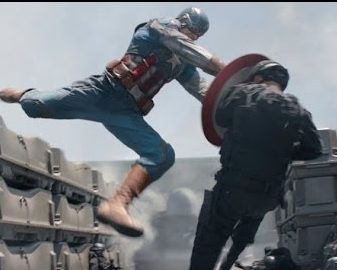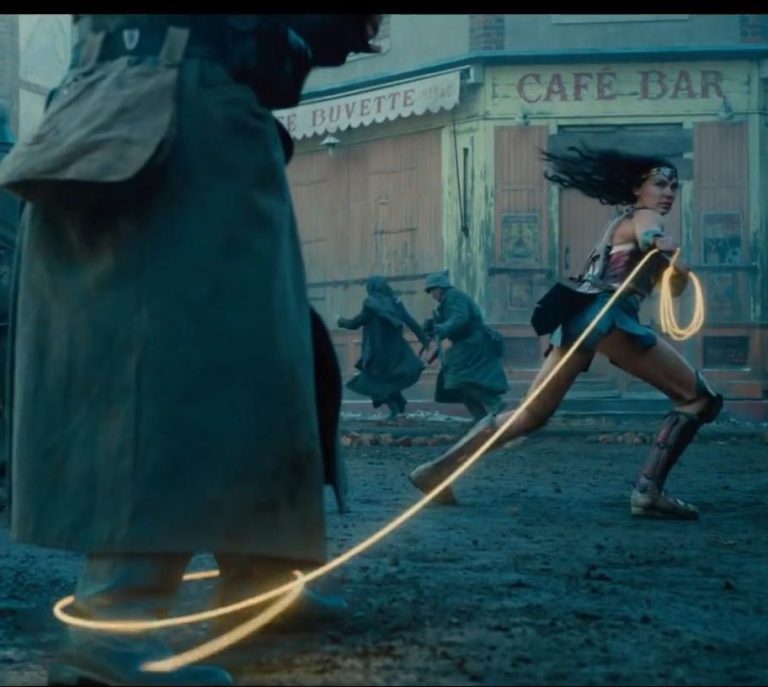How to Write Realistic Fight Scenes
Today’s guest post is by J. M. Robison.
After watching the final episode of Grimm, it occurred to me that being realistic in fight scenes is not as obvious as I had believed.
Before I start making claims that I know what a realistic fight scene is, I need to prove why I know it: I’ve been in military police for twelve years in the US Army, as well as held a full-time job for five years as a deputy sheriff in Elko, NV.
In the final episode of Grimm (no worries, names are protected to prevent spoilers) Bad enters the room. Good, Joe, and Bill are in this room. Joe fights Bad briefly before Bad kills Joe. Good rushes to Joe’s side and sobs over his dead body for a good minute. Enraged, Good then rushes Bad. Bad deflects Good, then kills Bill. Good sees Bill fall mortally wounded and races to his side, sobbing over his dead body a full minute and then—enraged again—rushes Bad. Bad deflects Good again, knocking him unconscious, and Bad leaves.
Someone who hasn’t been in the military or served as a police officer might not see anything wrong with this. It was certainly allowable in Grimm, which is netting money on Amazon Prime. But I’ve vowed that everything I write will be as accurate as possible, and I plead for you to ingrain that same standard into yourselves.
The Reason That Scene on Grimm Is Not Realistic
I’ll explain by using a real event that happened in my life. My local city police force was asking for volunteers to help them train how to respond to a mall shooting. I volunteered to act as one of the victims in this faux shooting. Once the police officers entered the mall to neutralize the threat—guns up, body armor on—I was to run directly at them, screaming at the top of my lungs, “I’ve been shot! I’ve been shot!” and then collapse to the floor directly at their feet. Which I did.
The police officers walked around me. One even stepped over my body and kept going. They did not stop to render aid. They didn’t say anything to me. They all moved on deeper into the mall as if I wasn’t there.
Now I’m hoping you see a massive problem with this. I’ve been shot, right? Every second I come closer to death if I don’t receive aid immediately, right? Yes and yes. However, the shooter is still in the mall, and every second he is not neutralized is another second he might shoot someone else. Further, if those officers had stopped to render aid, taking their eyes off their objective and lowering their guard, that shooter could step around a corner and shoot the officers.
A dead police officer won’t render aid and won’t stop the shooter from killing anyone else. So the shooter must first be stopped, and then, only when the scene is secure, will the officer come back and render aid. The military teaches this as well. I might be dead by then, but at least no one else will have died as a result of the shooter.
In that episode of Grimm, Bad kills Joe, and Good sobs over Joe’s body a good minute. While Good is distraught over the death of his friend, Bad is still standing there and could have killed Good while he was distracted with his dead/wounded friend.
If Good hadn’t been sobbing over Joe’s body and had neutralized Bad instead, Bill may not have died. But Bill did die because the threat was not neutralized. Because Good was distracted by his wounded friend.
To make a realistic fight scene, your character must first neutralize the threat, because if the threat is not neutralized, the threat will next attack other people or your character, whether your character is sobbing over their dead friend or whether your character is prepared to meet the attack.
Who Did It Right
Harry Potter and the Chamber of Secrets: when Harry, Hermione, and Ron are playing the life-sized chess game and Ron sacrifices himself to make a vital move. Ron gets badly hurt, and Harry starts to step off his chess square to help him, but Hermoine stops Harry, saying they were still in the game. They left Ron there, finished the game, and then went to Ron’s aid.
Return of Jafar: Final scene when Jasmin is magicked into an hourglass, and sand fills the bottom. Aladdin doesn’t rush to save her because Jafar is still trying to kill him. Aladdin fights Jafar first, and once he is neutralized he breaks the hourglass and frees Jasmin.
Why Writers Ignore What I Just Said
Death shakes us to our souls, whether it’s a justified killing (police officers, military) or the natural death of a loved one. Death sticks with us, which is why we have funerals and a marked grave to find the dead again. Which is why military and police officers get PTSD from taking a life.
This is realistic. We transfer this realism into our books and movies and cause characters to weep over the death of a good friend, which is what Good did during the final episode of Grimm. Death is beautiful in a sadistic way. We glamorize this death in books and movies by using slow motion, by spending a minute to air our griefs and acknowledge the passage from life. That is what Good did. That is why the producers of Grimm did it. Because it’s realistic.
However . . .
Good is featured as a police officer in Grimm. If he’s trained as a police officer, he should know that he needs to neutralize the threat before he attends to the wounded, just as I, a real-life police officer, have been trained. So his not neutralizing the threat goes against his training. Not realistic.
But Your Character May Not Be a Police Officer
It doesn’t matter. Now you’re contending with every human’s core instinct: survival. If you and your friend are out walking, and a shooter steps out from behind a building and shoots your friend, will you drop to your knees and sob over your wounded friend, or will you get the heck out of there to find cover where you can be safe for the moment to place a frantic 911 call?
I bet you’re going to run for cover, because your brain shuts down, and one word will gear your limbs to move. That word is SURVIVAL. You’ll get to your cover, and once you take a breath, your first thought will be “How did I get to this spot?” The second: “I hope the shooter doesn’t come after me.” And only then will your thoughts spring back to normal with a “My friend is hurt! Dial 911!”
That scenario will change slightly, depending on the skill set of your character. If your character is a soldier or police officer, she would be trained to run toward the sound of gunfire, and one word will gear her limbs to move: NEUTRALIZE. She will most likely run at the shooter to stop him from hurting other people.
In conclusion: to make a realistic fight scene, your character must first neutralize the threat before attending to the wounded. If your character is not a fighter and can’t neutralize the threat, his survival instincts will kick in and he will seek cover first, to assure his safety, and only when he feels it is safe to do so will he come out and help the wounded. Leave the dead and wounded until it is safe to tend to them.
 J. M. (Jane) Robison currently works as a deputy sheriff in Elko County, NV, and has been serving in the U.S. Army reserves for twelve years with a nine-month deployment to Afghanistan and Romania. Her debut novel, The War Queen, can be purchased here on Amazon. Jane plans three more fantasy novels to be released this year. Connect with J. M. directly at her website, Facebook, or Twitter.
J. M. (Jane) Robison currently works as a deputy sheriff in Elko County, NV, and has been serving in the U.S. Army reserves for twelve years with a nine-month deployment to Afghanistan and Romania. Her debut novel, The War Queen, can be purchased here on Amazon. Jane plans three more fantasy novels to be released this year. Connect with J. M. directly at her website, Facebook, or Twitter.







This good advice is also applicable to historical settings. In the First World War (and again in the Second), infantrymen were routinely told not to stop to render first aid to any of their comrades who were hit. They were told that stretcher bearers and medics would follow behind to do that. Modern EMS services are also created ‘tactical’ medical teams to follow Police/SWAT/etc. into dangerous situations to provide aid to first responders and victims while the police concentrate on their jobs.
This is actually why–in real life–there are Tactical EMTs trained to go in with police. They aren’t armed, but have body armor, and it is their job to triage and either leave, haul out, or stuff in some Combat Gauze to stop bleeds. Only EMTs with this tactical training go in–everyone else stays back until the police do secure a scene.
Another good point for writers to remember is that not everyone who is shot will immediately fall to the ground. That’s only on television and in the movies. There are many factors as to why people do not go down—adrenaline, drugs, alcohol, insanity, etc.
Good article.
A good lesson.
I think it’s a larger principle for writing (and surviving) fights: never take your eye off the question “what’s the enemy doing Right Now?”
A good fight scene bounces every second off that question; it choreographs the fight so that every moment the villain isn’t killing the hero there’s a reason for it. And the scene captures the weight the hero is under, knowing there can be a new attack coming at him every moment– and how an ordinary person locks onto SURVIVE while a professional has that more focused reaction to NEUTRALIZE.
I agree with Ken Hughes. His points are spot on. I’m fortunate in that I took and taught martial arts for years. While I haven’t incorporated martial arts in any of my scenes, it has helped me to understand the mind of the attacker and the attacked. Ken is right. A pro seeks to neutralize, while an ordinary person wants to survive or flee.
I have one scene where brothers are battling it out in an office setting. Neither is fighting to kill, but it’s ugly just the same. Having been on both sides of a fight in the ring lends me a great deal of insight to each roll. If a writer wants to truly understand a fight in order to write it in a compelling way, digging deeper into the mindset, I recommend a self defense class. Serves 2 purposes, writing, and safety.
This is some great advice, especially for those of us who haven’t served in the military or on a police force. I just need to point out that the two movies that did it right were actually “Harry Potter and the Sorcerer’s Stone” and “Aladdin.” This article is so important and well written that I didn’t want errors like these to take away from the message. Other than that, well done!